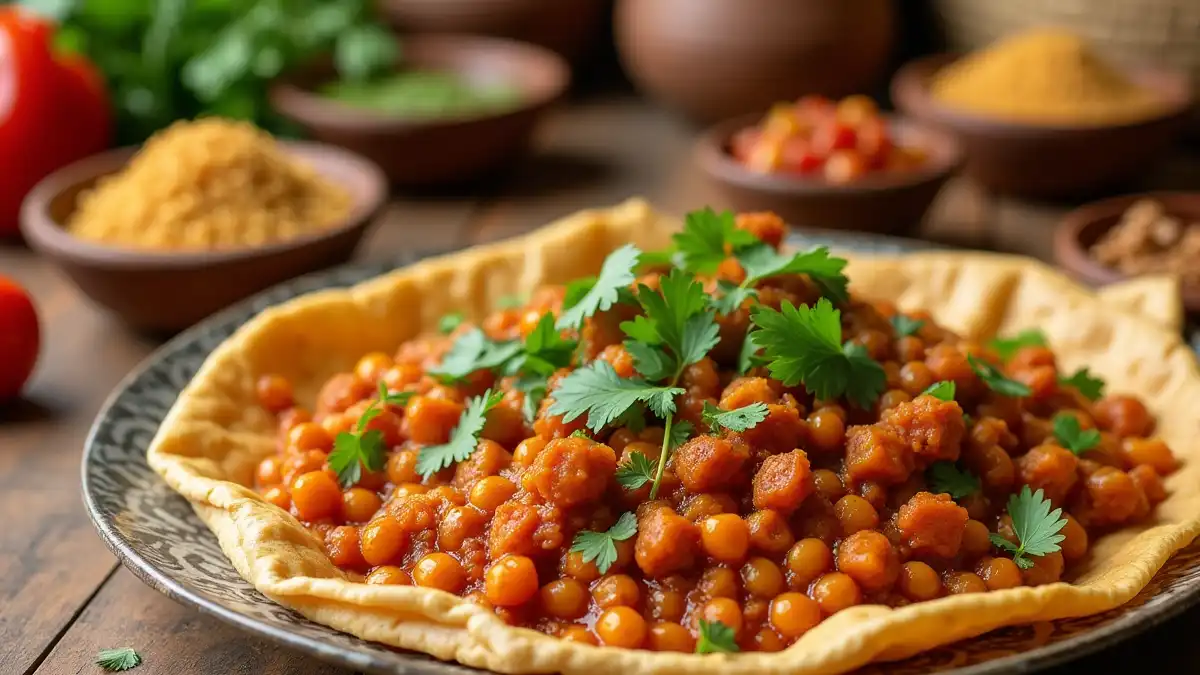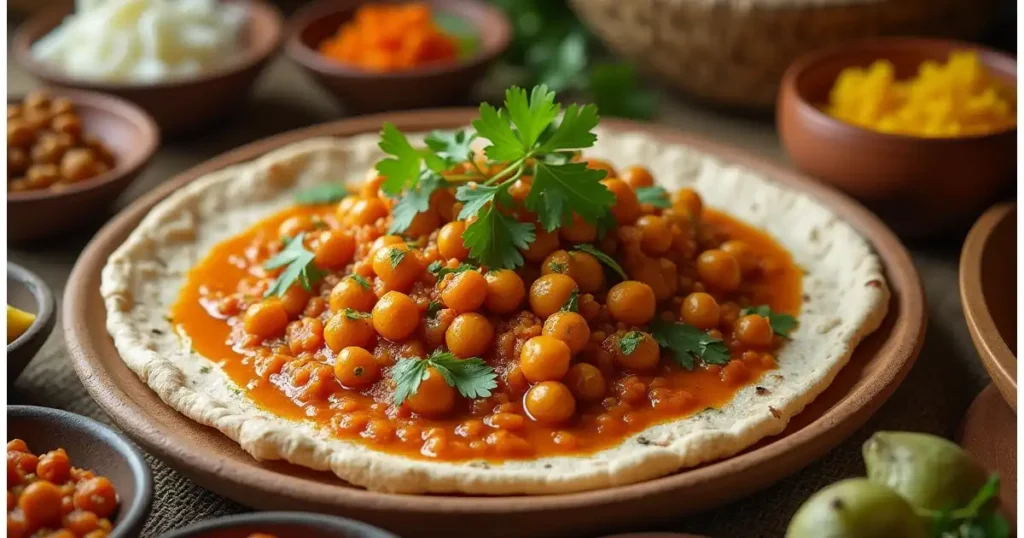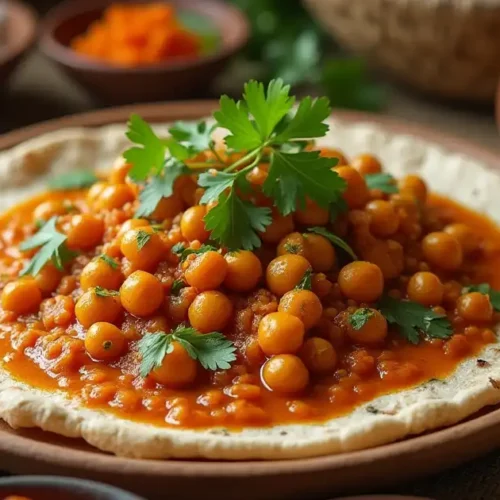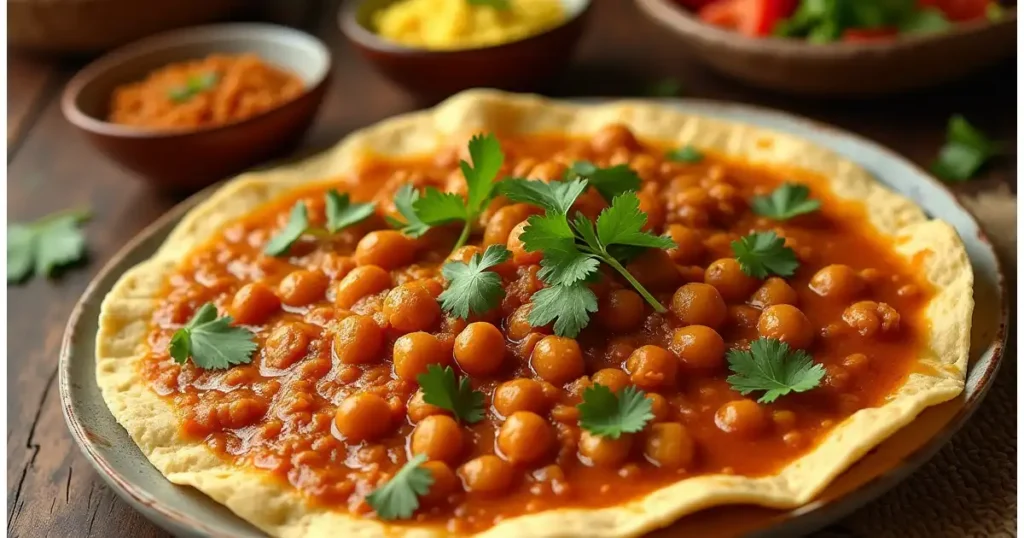
Table of Contents
Introduction
Ethiopian cuisine is known for its rich, aromatic flavors and diverse range of stews. One standout dish is Chickpea Wat, a hearty, spiced stew made primarily from chickpea flour. Also known as Shiro Wat, this dish has been a staple in Ethiopian households for generations.
As more people embrace vegan and gluten-free diets, Chickpea Wat has gained popularity worldwide for its nutrient-rich, plant-based ingredients. Packed with bold spices and comforting textures, it’s a satisfying dish that’s easy to prepare at home.
In this article, we’ll explore the cultural significance, essential ingredients, and step-by-step process to help you master this Ethiopian classic in your own kitchen.


Chickpea Wat: 7 Irresistible Reasons to Love This recipe!
Ingredients
Base Ingredients:
- 1 cup chickpea flour (besan)
- 3 cups water or vegetable broth
- 2 tbsp Niter Kibbeh (Ethiopian spiced butter) or olive oil (vegan)
Seasonings & Spices:
- 1 large onion finely chopped
- 3 cloves garlic minced
- 1 tbsp Berbere spice blend
- 1/2 tsp salt (adjust to taste)
- 1 small tomato grated (optional, for extra depth)
Instructions
- 1. Sauté the Onions:Heat Niter Kibbeh (or oil) in a pan over medium heat.Add finely chopped onions and sauté until golden brown (about 5 minutes).2. Add Garlic & Berbere Spice:Stir in minced garlic and Berbere spice blend.Cook for 1-2 minutes until fragrant.3. Incorporate Chickpea Flour:Gradually add the chickpea flour, stirring constantly to prevent lumps.4. Slowly Add Water/Broth:Pour in warm water or vegetable broth, a little at a time while stirring.Keep stirring to maintain a smooth consistency.5. Simmer Until Thick & Creamy:Lower the heat and let the stew simmer for 10-15 minutes, stirring occasionally.If the stew gets too thick, add a bit more water to reach the desired consistency.6. Taste & Adjust:Add salt to taste and extra Berbere spice for spicier flavor if desired.7. Serve & Enjoy!Chickpea Wat is best served hot, traditionally with injera bread or over rice.
Notes
Nutrition Facts (Per Serving – Approximate):
- Calories: 280
- Carbohydrates: 38g
- Protein: 12g
- Fat: 8g
- Saturated Fat: 2g
- Fiber: 7g
- Sodium: 350mg
Recipe Notes:
✔ Adjust spice levels by adding more or less Berbere.✔ For a milder version, add coconut milk to balance the heat.
✔ Enhance with veggies like carrots, potatoes, or bell peppers for extra texture.
Understanding Chickpea Wat
What is Chickpea Wat?
Chickpea Wat, or Shiro Wat, is a traditional Ethiopian stew made from chickpea flour cooked with a flavorful blend of spices. It’s known for its smooth, creamy texture and rich, deep-red color, thanks to the use of Berbere spice.
How is Chickpea Wat Different from Other Ethiopian Stews?
Unlike Doro Wat (which uses chicken) or Misir Wat (made with lentils), Chickpea Wat is completely plant-based. The use of finely ground chickpeas creates a naturally thick and protein-rich consistency, making it a favorite among those following vegetarian or gluten-free diets.
The Cultural Significance of Chickpea Wat
In Ethiopia, Shiro Wat is a common dish enjoyed in both everyday meals and special occasions. It’s a comfort food often served during fasting periods in Ethiopian Orthodox traditions, where meat and dairy are avoided. Its simplicity and affordability make it a beloved staple in many households.
Essential Ingredients for Making Chickpea Wat
To create an authentic Chickpea Wat, you’ll need a few key ingredients that define its taste and texture.
1. Chickpea Flour (Besan)
Chickpea flour is the base of this dish, providing a nutty flavor and thick consistency when cooked. It’s a great source of plant-based protein and fiber, making Chickpea Wat both filling and nutritious.
2. Berbere Spice Blend
The soul of Ethiopian cuisine, Berbere is a bold, aromatic spice mix made from a blend of:
- Paprika – adds color and mild sweetness
- Cumin & Coriander – for warm, earthy undertones
- Fenugreek – a key ingredient that enhances the deep, slightly bitter complexity of the stew
- Ginger, Garlic, and Chili Powder – to bring heat and depth
3. Niter Kibbeh (Spiced Clarified Butter)
This fragrant Ethiopian butter is infused with cardamom, cinnamon, garlic, and ginger, giving Chickpea Wat a rich, authentic flavor. If you prefer a vegan version, you can substitute Niter Kibbeh with olive oil or vegan butter while still maintaining a depth of taste.

Step-by-Step Guide to Preparing Delicious Chickpea Wat
Ingredients:
- 1 cup chickpea flour
- 2 tbsp Niter Kibbeh (or olive oil for a vegan version)
- 1 large onion, finely chopped
- 3 cloves garlic, minced
- 1 tbsp Berbere spice
- ½ tsp salt (adjust to taste)
- 3 cups water or vegetable broth
- 1 small tomato, grated (optional, for extra depth)
Cooking Instructions:
- Sauté the Onions:
- Heat Niter Kibbeh (or oil) in a pan over medium heat.
- Add the finely chopped onions and sauté until they become soft and golden brown.
- Add Garlic and Berbere:
- Stir in the minced garlic and Berbere spice blend.
- Cook for about 1-2 minutes until fragrant.
- Incorporate the Chickpea Flour:
- Gradually sprinkle in the chickpea flour, stirring constantly to prevent lumps.
- Slowly Add Water or Broth:
- Pour in warm water or vegetable broth a little at a time while stirring.
- The mixture will start to thicken—keep stirring to maintain a smooth consistency.
- Simmer to Perfection:
- Lower the heat and let the stew cook for 10-15 minutes, stirring occasionally.
- If it gets too thick, add a bit more water to reach your desired consistency.
- Taste and Adjust:
- Add salt to taste. If you prefer more spice, sprinkle in extra Berbere or fresh chili.
- Serve & Enjoy!
- Chickpea Wat is best enjoyed hot, paired with injera bread or rice.
Exploring Variations and Personalizing Your Chickpea Wat Recipe
1. Adjusting Spice Levels
Love heat? Add fresh jalapeños or extra Berbere spice. Prefer milder flavors? Reduce the spice blend slightly and add a bit of coconut milk for a creamy twist.
2. Adding Extra Ingredients
Some regional variations include:
- Carrots & Potatoes – for added texture and sweetness
- Red Lentils – for extra protein and a thicker consistency
- Tomatoes & Bell Peppers – for a tangy, fresh element
Serving and Enjoying Chickpea Wat Like an Ethiopian Local
Traditional Serving Method
Chickpea Wat is traditionally served on a large plate of Injera, a spongy, sourdough flatbread that complements its rich flavors.
Communal Dining Culture
In Ethiopian tradition, meals are enjoyed family-style, with everyone dipping into the shared plate of stew using pieces of injera instead of utensils. This communal approach enhances both connection and flavor appreciation.
Storing Leftover Chickpea Wat: Tips for Preservation Without Compromising Flavor
Refrigeration:
- Store in an airtight container for up to 3-4 days.
- Reheat gently on the stove with a splash of water to restore texture.
Freezing:
- Chickpea Wat freezes well for up to 2 months.
- Defrost in the fridge overnight and reheat slowly while stirring.
Conclusion: Embrace the Hearty Flavors of Ethiopian Cuisine with Homemade Chickpea Wat!
Trying Chickpea Wat at home is a delicious way to explore Ethiopian cuisine while enjoying a wholesome, plant-based meal. Whether you’re looking for a hearty vegan dish or just want to expand your culinary experiences, this traditional stew is a must-try.
🌿 Ready to cook? Gather your ingredients, follow the steps, and enjoy a taste of Ethiopia in your own kitchen!
📌 Save this recipe & share your results in the comments! Happy cooking!
Choose what you like from the Lunch menu to start your day happily
FAQ
What is a binder for chickpea burgers?
A binder helps hold chickpea burgers together and prevents them from falling apart. Common binders include breadcrumbs, oat flour, ground flaxseeds (flax egg), chia seeds, mashed potatoes, or eggs (for non-vegan options). Adding a little water or oil can also help create a cohesive texture.
Are chickpeas healthy or fattening?
Chickpeas are highly nutritious and not inherently fattening. They are rich in protein, fiber, vitamins, and minerals, which help keep you full and support digestion. However, overeating them in large amounts, especially in fried or processed forms, can contribute to weight gain.
How do you keep chickpea burgers from falling apart?
To keep chickpea burgers from falling apart:
- Use a binder like breadcrumbs, oat flour, or flax eggs.
- Mash the chickpeas well to create a sticky texture.
- Let the mixture rest in the fridge for 30 minutes before shaping.
- Avoid adding too much moisture—if the mix is too wet, add more dry ingredients like flour or breadcrumbs.
Are chickpeas and garbanzo beans the same?
Yes! Chickpeas and garbanzo beans are the same legume. “Chickpea” comes from English, while “Garbanzo” is derived from Spanish. Both terms refer to Cicer arietinum, a nutrient-dense pulse used in global cuisines.
What helps veggie burgers stick together?
To help veggie burgers stick together, use ingredients that add moisture and binding properties, such as:
- Flax eggs (1 tbsp flaxseed + 3 tbsp water)
- Chia seeds (same ratio as flax eggs)
- Mashed potatoes or sweet potatoes
- Nut butters (like almond or peanut butter)
- Cooked quinoa or rice
- Breadcrumbs or oat flour
What is chickpea water?
Chickpea water, also known as aquafaba, is the liquid left over from cooking chickpeas or found in canned chickpeas. It is commonly used as a vegan egg substitute due to its ability to whip into a foam similar to egg whites.
What is Wat and Injera?
- Wat is a traditional Ethiopian stew made with spices, vegetables, and sometimes meat or legumes like chickpeas (Chickpea Wat or Shiro Wat).
- Injera is a spongy, sourdough flatbread made from teff flour, which is used as both a plate and utensil in Ethiopian cuisine, perfect for scooping up Wat.
Can you eat chickpea water?
Yes! Chickpea water (aquafaba) is safe to eat and is often used in recipes like vegan meringues, mayonnaise, pancakes, and baking as an egg replacement. However, some people prefer to boil it slightly to improve texture and taste.
Is chickpea a carb or protein?
Chickpeas are both a carb and a protein. They contain complex carbohydrates (about 27g per 100g) and a good amount of plant-based protein (about 9g per 100g), making them a nutritious food choice.
Is drinking chickpea water good for you?
Drinking chickpea water (aquafaba) is generally safe, as it contains starch, protein, and some minerals. However, it may cause digestive discomfort in some people due to oligosaccharides (complex sugars that can be hard to digest).
Should you throw away chickpea water?
No, you don’t have to! Instead of throwing it away, you can use chickpea water as a vegan egg substitute in cooking and baking or as a base for soups and sauces. However, if you don’t need it, you can discard it.
What are the disadvantages of aquafaba?
- Low in protein compared to eggs
- Can cause bloating due to its complex sugars
- Varies in consistency depending on the brand of chickpeas used
- Contains sodium if using canned chickpeas (can be reduced by rinsing)
Can you buy chickpea water?
Yes! Some brands now sell bottled aquafaba for convenience, especially in specialty and health food stores. However, you can also make your own by saving the liquid from canned or home-cooked chickpeas.